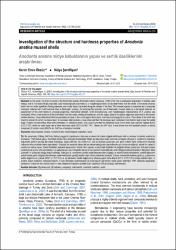| dc.contributor.author | Öksüz, Kerim Emre | |
| dc.contributor.author | Şereflişan, Hülya | |
| dc.date.accessioned | 2023-12-12T09:54:09Z | |
| dc.date.available | 2023-12-12T09:54:09Z | |
| dc.date.issued | 2023 | en_US |
| dc.identifier.citation | Oksuz, K. E., Sereflisan, H. (2023). Investigation of the structure and hardness properties of Anodonta anatina mussel shells. Ege Journal of Fisheries and Aquatic Sciences, 40(2), 132-139.
https://doi.org/10.12714/egejfas.40.2.07 | en_US |
| dc.identifier.issn | 1300-1590 | |
| dc.identifier.issn | 2148-3140 | |
| dc.identifier.uri | https://doi.org/10.12714/egejfas.40.2.07 | |
| dc.identifier.uri | https://hdl.handle.net/20.500.12508/2632 | |
| dc.identifier.uri | http://www.egejfas.org/tr/pub/issue/77885/1211624 | |
| dc.description.abstract | In this study, the shell structure of the freshwater mussel Anodonta anatina (Linnaeus, 1758) which has a widespread population in Golbasi Lake (Hatay) and is not economically exploited, was microscopically examined at a morphological level. It was determined that the shells of Anodonta anatina, which are not under significant fishing pressure, are mostly found discarded along the shores of the lake. This mussel species is important as a composite biological material with multifunctional roles in freshwater ecology. Considering the potential use of freshwater mussel shells as a biological material, an assessment of the shell structure, physical properties, mechanical strength, shell microstructure, and morphological characteristics of A. anatina was conducted. When cross-sections of the shell taken from the umbo, middle periostracum, and the region close to the pallial edge were examined in the dorsal-ventral direction, it was determined that the periostracum layer in the umbo region had a more prismatic and polygonal structure. The interior of the shell was found to consist of a shiny nacreous layer. In nacreous shell sections, it was observed that the nacreous layer contained more distinct layers near the pallial edge. Vickers microhardness tests were performed on individual shells, and it was found that the hardness value of the inner layer was the highest (625.5 +/- 172.7 HV), while the outer layer had a lower hardness value (531.5 +/- 110.7 HV). Based on XRF data, it was shown that the seashell powder is mainly composed of calcium oxide (98.8% wt., CaO) as a biological material. | en_US |
| dc.language.iso | eng | en_US |
| dc.publisher | Ege Üniversitesi | en_US |
| dc.relation.isversionof | 10.12714/egejfas.40.2.07 | en_US |
| dc.rights | info:eu-repo/semantics/openAccess | en_US |
| dc.subject | Biocomposite | en_US |
| dc.subject | Bivalve | en_US |
| dc.subject | Microhardness | en_US |
| dc.subject | Morphological properties | en_US |
| dc.subject | Nacre | en_US |
| dc.subject.classification | Chemistry - Nanofibers, Scaffolds & Fabrication - Calcium Carbonate | |
| dc.title | Investigation of the structure and hardness properties of Anodonta anatina mussel shells | en_US |
| dc.title.alternative | Anodonta anatina midye kabuklarının yapısı ve sertlik özelliklerinin araştırılması | en_US |
| dc.type | article | en_US |
| dc.relation.journal | Ege Journal of Fisheries and Aquatic Sciences | en_US |
| dc.contributor.department | Deniz Bilimleri ve Teknolojisi Fakültesi -- Su Ürünleri Yetiştiriciliği Bölümü | en_US |
| dc.identifier.volume | 40 | en_US |
| dc.identifier.issue | 2 | en_US |
| dc.identifier.startpage | 132 | en_US |
| dc.identifier.endpage | 139 | en_US |
| dc.relation.publicationcategory | Makale - Uluslararası Hakemli Dergi - Kurum Öğretim Elemanı | en_US |
| dc.contributor.isteauthor | Şereflişan, Hülya | |
| dc.relation.index | Web of Science | en_US |
| dc.relation.index | Web of Science Core Collection - Emerging Sources Citation Index | |
















